- This
photo essay tells if Cholas were Hindus, evaluates nature of sculptures in
three biggest Chola temples, origin of words Hindus & Hinduism and reasons
behind creating this controversy.
As
someone who is not a resident of Tamil Nadu but widely travelled within the
state I was surprised to hear statement that Cholas were not Hindus. So what
was said?
This India Today report states, “National award winning Tamil director Vetrimaaran's statement that Raja Raja Cholan was not a Hindu king has opened the floodgates for a debate regarding the emperor's religious identity. “Continuously, our symbols are being snatched from us. Saffronising Valluvar or calling Raja Raja Cholan a Hindu King is constantly occurring”.” Further, as per The
Hindu, Viduthalai Chiruthaigal Katchi president Thol. Thirumavalavan said, “There was no Hinduism during the time of Cholas.”
Note that Chola Emperor Rajaraja Chola is a central figure, in the recently released movie ‘Ponniyin Selvan - I’. “Tamil actor Karunas said that Raja Raja Chola was a Tamil king and the fact that he followed Shaivism has got nothing to do with Hinduism as Hinduism is a later construct.” Source
Swarajyamag Politician and actor
Kamal Hassan, who last made headlines when he threatened to leave India if the ban
on his movie Vishwaroopam was not lifted, supported the film maker.
Their
spokesperson R Vikraman who came on CNN-News18 on October 6,
said Saivites are not Hindus. Later he jumped on to Caste, Manusmriti and
Ambedkar. Anchor Shivani Gupta dealt with his inconsistency pretty well.
Thirumavalavan
also mentioned about the Lingayat demand for a separate religion. Before the
2018 Karnataka Assembly elections the Congress stated that Lingayats are
separate from Hinduism.
Subsequently, former British Council Scholar Dr Satish K Kapoor wrote, “Virashaivism
regards Shiva and Shakti as fundamental to existence: Shakti is Shiva, like
fragrance in a flower. It preaches a form of qualified non-dualism, called shakti-vishishtadvaita, which considers god and the human soul as one, like the sun and its rays.” To read more Understanding
Veerashaivas, Lingayats and Sanatana Dharma
A producer should be concerned about box-office collections not alleged saffronising of individuals. Post controversy, more crowds might see movie including the subsequent parts.
So
the points made are Rajaraja Chola was a Tamil and not a Hindu king (being a
Saivite did not mean he was Hindu), Tiruvalluvar and Raja Raja were being
saffronised and Hinduism did not exist during the time of the Cholas (Vijayala
850 to Rajaraja II 1173 A.D.) 1 Pg.
13
There
is some merit in the last point. Problems arise because the British before 1947
and successive governments thereafter have used colonial terms to define Indians.
Let us now evaluate each of the points raised.
1. Did words Hindu and Hinduism exist then?
Scholar and ex-President Dr S Radhakrishnan wrote: “The people on the Indian side of the Sindhu were called Hindu by the Persian and the later western invaders (The Hindu View of Life by Dr Radhakrishnan Pg. 12). The term ‘Hindu’ according to Dr Radhakrishnan had originally a territorial and not a creedal significance. It implies residence in a well-defined geographical area”. (Bramchari Siddheswar Shai v State of West Bengal, 1995 AIR Supreme Court 2089).
As per this definition
all those living in India were Hindus. This definition was apt till the Muslim
invasion. Later the invaders used the term Hindu to refer to original residents
and became a label to distinguish the locals from the invaders i.e. Muslims.
Pandit Rajmani Tugnait, Spiritual
head of the Himalayan Institute Pennsylvania wrote, ‘As part of their divide and rule policy the British used the words Hindu and Hinduism, emphasising the religious and political overtones of these words. Western writers then adopted these terms for the sake of convenience, and Eastern writers conformed to the norms set by those in power.’ 2
During British rule the word Hindu became Hinduism just like Marx became Marxism. The word Hinduism is not representative of the original word ‘Sanatana Dharma’ which means ‘the Eternal or Universal Dharma’. Dharma means universal law, the fundamental principles behind this marvellous universe like the Law of Karma. Sanatana means perennial, referring to eternal truths that manifests in ever-new names and forms.’
The filmmaker is right that
what existed during the Cholas period was not Hinduism. It was Sanatana Dharma with
its followers being Saiva, Shakti, Vaishnav etc.
To end this confusion, the Government of India must change laws to
use Sanatana Dharma instead of Hinduism and Dharma instead of Hindu.
Also read Hindi,
Hindu, Hindustani
Colonization
has created another problem. Philosophy is a Western word which mainly relies
on intellectual pursuit. The corresponding Indian word is Darsana which
relies on direct vision of truths (experienced by ancient sages all over Bharat) and pure Buddhi
(reasoning).
India
has nine schools of darsanas meaning nine ways to achieve
self-realisation. These are Nyaya, Vaisheshika, Sakhya, Yoga, Mimamsa, Vedanta, Carvaka, Jaina and Buddha. Others are a mixture of the ideas of these systems.
Note that there is no Hindu or Sikh school of philosophy. Today, people wanting to be declared a non-Hindu is encouraged by reservations, benefits etc for them. The word ‘minority’ too is a colonial import. Also read Who
is a Minority
We see not what unites us but insist that differences between two paths makes one a minority. Pandit Tugnait wrote that common characteristics of Indic schools are, “direct experience, acceptance of authority, harmony amongst schools, parallel growth and co-existence of so many schools, open mindedness, support of logic and reasoning, belief of eternity, law of karma, moral and ethical teachings, acknowledgement of suffering, thoroughness, practicality and being inward looking.” 2
Today some forms of darsana are treated as religion. For example, a book by Munisri Nyayavijayaji. If I read it in Gujarati the book’s title is ‘Jaina Darsana’, in English it is Jaina Philosophy and Religion.
Also read Comparing
Indic faiths vs. Abrahamic Religions
2. Was Raja Raja Chola a Hindu King?
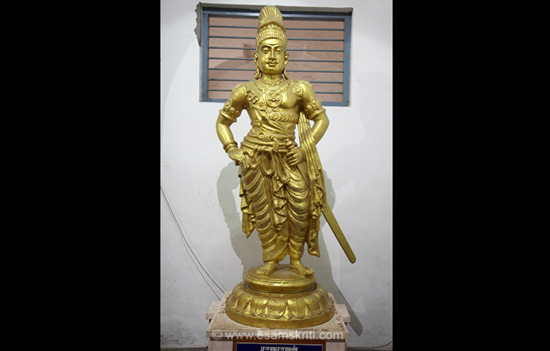 Rajaraja Chola. Art Gallery Maratha Palace, Thanjavur.
Rajaraja Chola. Art Gallery Maratha Palace, Thanjavur.
Rajaraja
was an ardent devotee of Thyagarajaswami. The temple at Thiruvarur is
considered to be one of the holiest of the 275 Saivite shrines. Source Temples of Tamil Nadu by PGL Sakambharee
Pg. 37. To
see pictures of temple
To read scholar Dr Karan Singh statement on hearing some say that Rajaraja was not a Hindu king click on PDF
Author
has explained origin of the Hindu. To know whether the Cholas esp. Rajaraja fall
within the definition of what we call Hindu today let us see sculptures of
three most important temples made.
Brihadesvara Temple, Thanjavur (Rajaraja I 985-1012)
Sharing
pictures of some Hindu elements in temple.
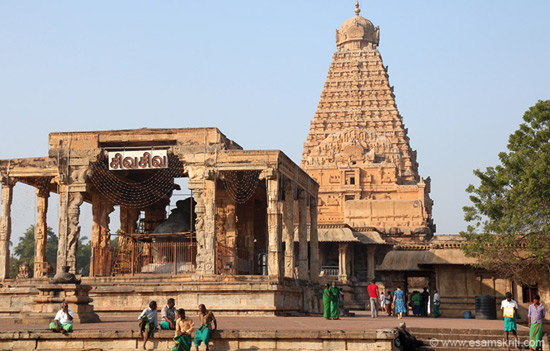 Temple view. It is believed that the Sivalinga (3.66 m) was first installed and temple built around it.
Temple view. It is believed that the Sivalinga (3.66 m) was first installed and temple built around it.
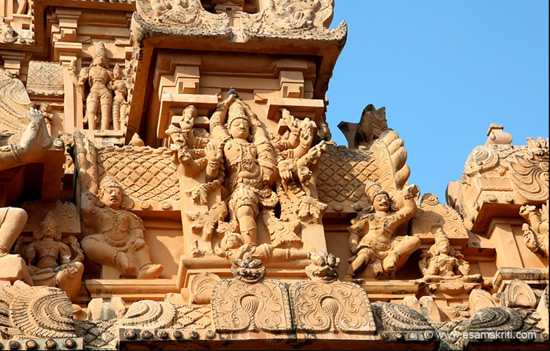 Rudhra Thandava (Shivji).
Rudhra Thandava (Shivji).
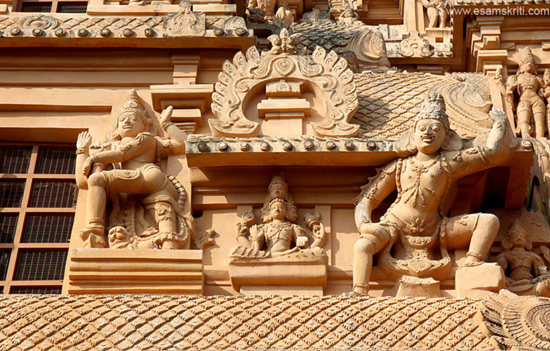 Stucco images of centre of gopuram east side. In centre 4 heads is Brahma.
Stucco images of centre of gopuram east side. In centre 4 heads is Brahma.
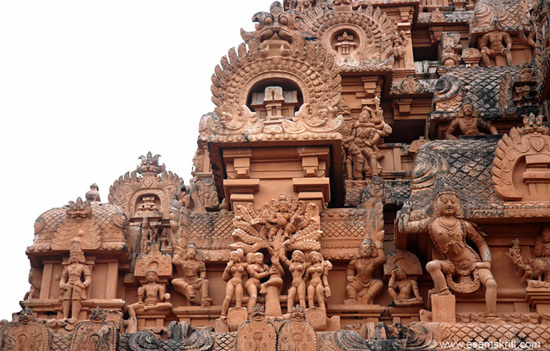 Centre is Krishnavastaram. Krishna took away dress of 4 Gopis, sat on tree. Top Kirtimukha is found in Hindu & Jain temples.
Centre is Krishnavastaram. Krishna took away dress of 4 Gopis, sat on tree. Top Kirtimukha is found in Hindu & Jain temples.
 Mural painting in temple corridor. Lord Murugan with consorts Valli and Devasena.
Mural painting in temple corridor. Lord Murugan with consorts Valli and Devasena.
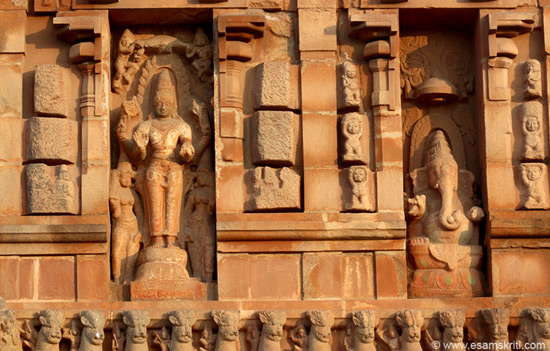 Right is Ganesha, left is Mahavishnu.
Right is Ganesha, left is Mahavishnu.
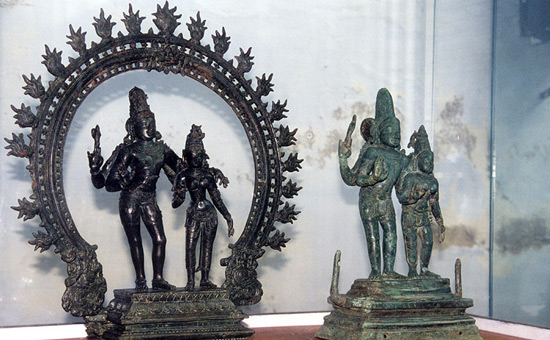 Nataraja.
Nataraja.
Art historian Benoy K Behl wrote, “The most magnificent image in the bronzes is the Nataraja, Shiva in his cosmic dance. In this dance, he creates and destroys the world. The richness of symbolic meaning in the Nataraja image makes it one of the greatest icons created by man.”
Also read Chola
Bronzes-Darshan of the Divine N Siva’s Infinite Column of Fire-Jwala Linga
Only a Hindu king would have a temple made like this. To
see album of Brihadesvara Temple
Shivji
worship is not limited to Tamil Nadu but is across India and beyond. See.
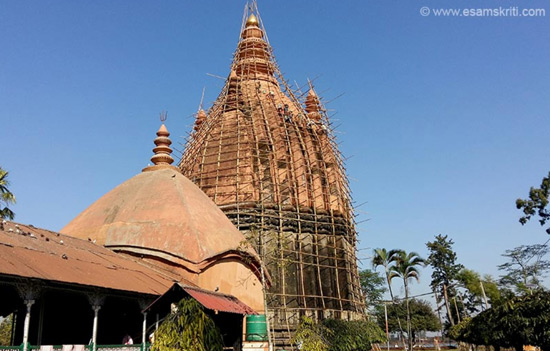 Sivadol Temple, Sivasagar, Assam.
Sivadol Temple, Sivasagar, Assam.
 Lingaraja Temple, Bhubaneshwar.
Lingaraja Temple, Bhubaneshwar.
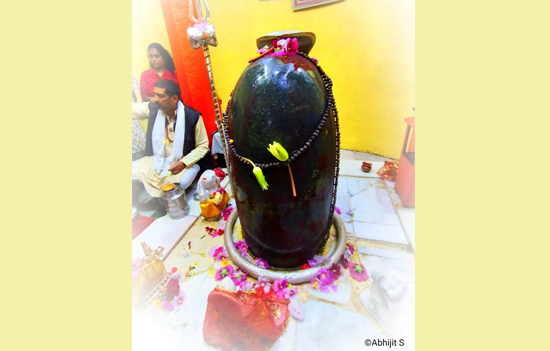 Jyeshta Rudra Linga at Sankaracharya Mandir, Srinagar. Pic by Abhijit Sadhale.
Jyeshta Rudra Linga at Sankaracharya Mandir, Srinagar. Pic by Abhijit Sadhale.
 Pashupathinath Nepal. Pic courtesy Hinduism Today.
Pashupathinath Nepal. Pic courtesy Hinduism Today.
Also read Light on Abhinavagupta's Contribution to the Advaita Shaiva Spiritual Philosophy of Kashmir
Gangaikondacholpuram Temple (Rajendra Chola 1012-1044)
To celebrate his victory, Rajendra created a liquid pillar of victory in his new capital at Gangaikondacholapuram, ‘the city of the Chola, the bringer of the Ganga’. 1 Pg. 5
Sharing
pictures of some Hindu elements in temple.
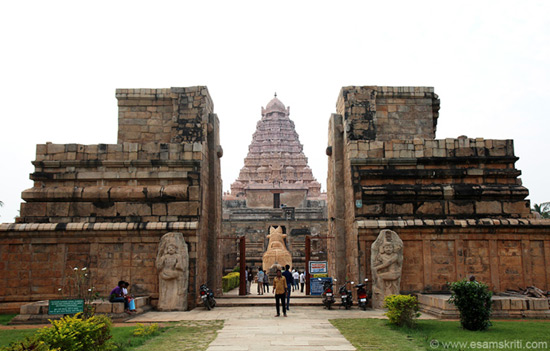 Entrance to temple. In centre is Nandi.
Entrance to temple. In centre is Nandi.
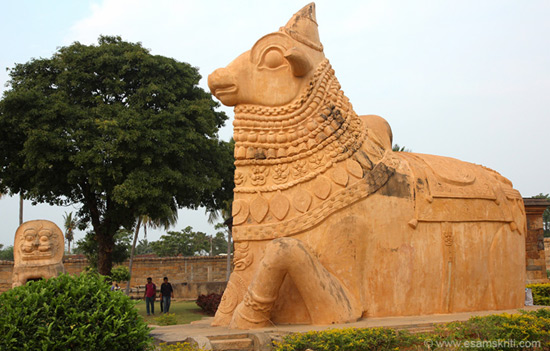 Nandi is 15 feet
in length, 11 feet in height and breadth of 8 feet. It is facing the Sivalinga.
Nandi is 15 feet
in length, 11 feet in height and breadth of 8 feet. It is facing the Sivalinga.
Columnist Seema Burman wrote, “In every Siva temple Nandi sits facing the Sivalinga. The tradition is that devotees whisper their wishes in Nandi’s ear, who tells Siva after His meditation is over.” To
read more esp. connect with Samudra Manthan
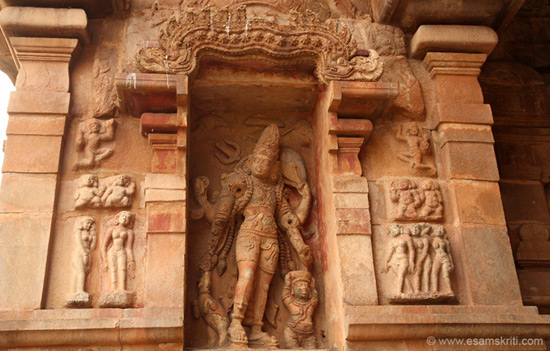 Bhairav form of Siva. In one hand is dog, in an another is human.
Bhairav form of Siva. In one hand is dog, in an another is human.
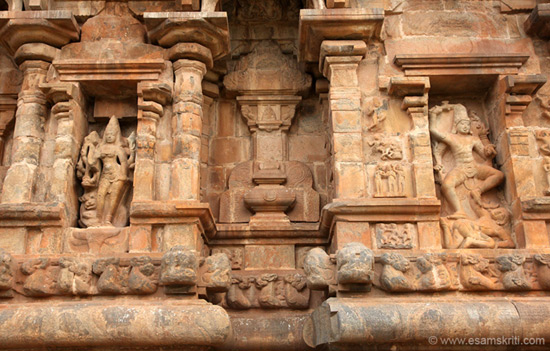 Right is Mahishasurmardini (trying to reconfirm). Left is Simhavahini. Centre is Kalash.
Right is Mahishasurmardini (trying to reconfirm). Left is Simhavahini. Centre is Kalash.
To
see temple album
Darasuram Temple, Kumbakonam (Rajaraja II 1150-1173)
Name
is Airavatesvara Temple. Airavatham is an elephant, white in colour and vehicle
of Lord Indra.
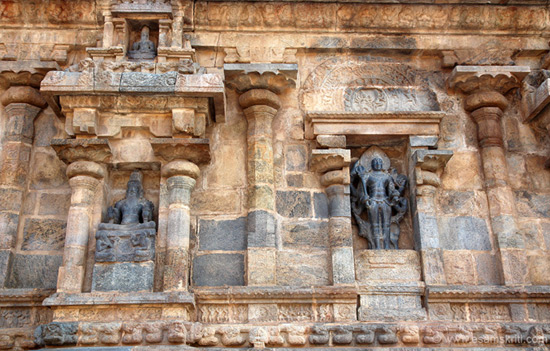 Right is Nagaraja.
Right is Nagaraja.
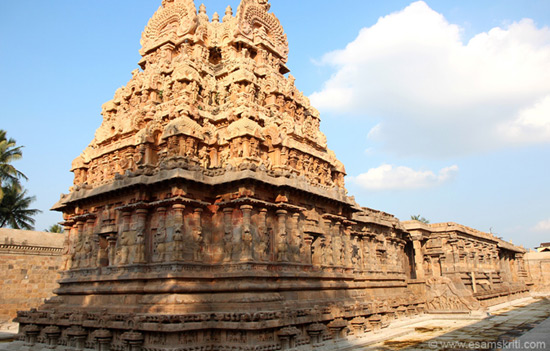 Parvati temple very close to main temple.
Parvati temple very close to main temple.
One
of the Navagraha temples, Suryanar Kovil Kumbakonam was made by Kultontunga I Chola
(1070-1122 AD). These are just a few of the many temples the Cholas made
starting 850 A.D. Credit Prof Dr. Ujjwala Khot Palsuley.
3. Saivism not part of Hinduism
Sharing
a few pictures that speak for themselves.
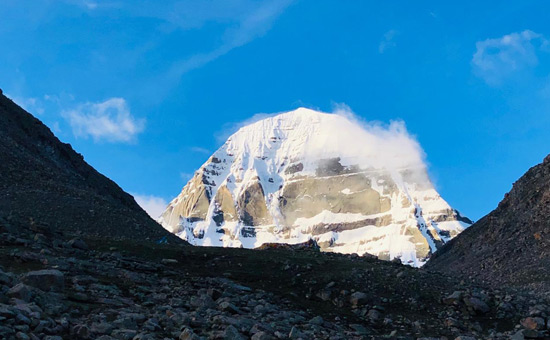 Mount Kailash, abode of Shiva attracts Hindus, Jains, Buddhists and Tibetans. Pic by Pratima Joshi.
Mount Kailash, abode of Shiva attracts Hindus, Jains, Buddhists and Tibetans. Pic by Pratima Joshi.
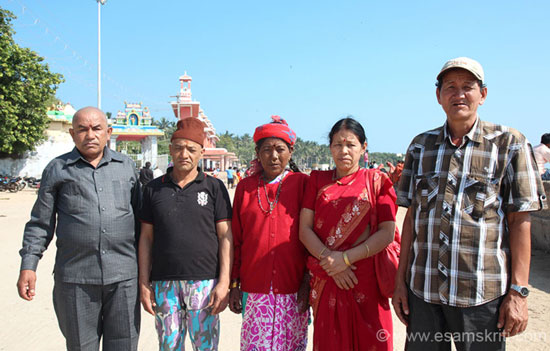 Devotees from Nepal at Rameshwaram. Pic 2016.
Devotees from Nepal at Rameshwaram. Pic 2016.
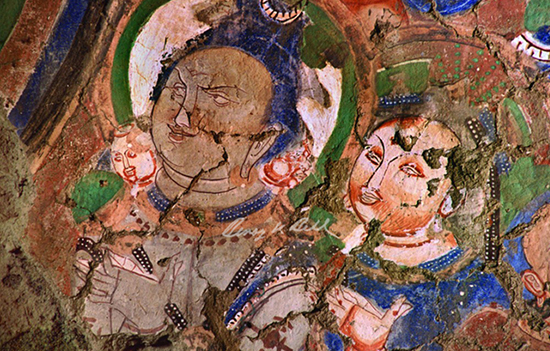 Shiva
and Parvati, Mural, Kizil Caves, Kucha, Xinjiang, 6th Century. Pic by Benoy K
Behl
Shiva
and Parvati, Mural, Kizil Caves, Kucha, Xinjiang, 6th Century. Pic by Benoy K
Behl
4. Appropriation of Tamil Icons – Fear of Hindus uniting
It appears that the movie ‘Ponniyin Selvan-I’ has renewed pride amongst Tamils in the achievements of their ancestors. It is a form of decolonization and nationalism. If true, the movie might unite Hindu voters of Tamil Nadu. This is something that the current dispensation fears will go against them and weaken the theme, ‘We Tamilians are different’.
Earlier
people criticised the Central government for not giving importance to state
heroes for e.g. Thirruvaluvar (Jain or Hindu is a matter of debate,
such distinctions are modern day creations), author of the much appreciated Thirukkural. Now when more Indians have
got know about him, it is being called Saffronization.
Also read Thiruvalluvar
birth anniversary celebrations - Time to correct historical wrong
Calling
Rajaraja I a Tamil and not a Hindu (read Indian) king smells of separatist
tendencies. Such people must remember these words of Freedom-fighter, historian
and founder of Bharatiya Vidya Bhavan Dr K M Munshi who wrote in Foreword to Volume 11, “In India the greatest danger is the formation of sub-nation States and linguistic chauvinism. Formation of states based on language was an administrative necessity and after Independence some adjustments were made but it was impossible to draw the boundaries of a state in such a manner as to totally exclude linguistic groups from the adjacent States. Nor is such a boundary necessary. We are citizens of India, not of any State, though the present trend is to identify oneself with his State rather than India.” 3
“This tendency has to be dealt with firmly without weakening the Centre or the federal bonds in any way. It has been the experience of history, that this subcontinent has fallen a prey to foreign invasion in the absence of a strong central authority. This lesson of history we had in mind when we adopted a quasi-federal constitution of India.” 3
5. Caste is a favourite punching bag
The
filmmaker spokesperson, Vikraman R, on TV spoke about caste system being associated with Hinduism and Ambedkar. Suggested reading –
The
Truth about Caste
Caste
as Social Capital
Were
Backward Classes always suppressed in India
How India’s family communities fostered entrepreneurship in India
Ambedkar
was also an Economist
Ambedkar
erred Buddha was Hindu
The
former rulers of Tripura are now classified as Scheduled Tribes. So there is a
bust of Dr Ambedkar at their palace gate in Agartala. Similarly, the Dhangar
community to which Queen Ahilyabai Holkar belonged want to be classified as ST.
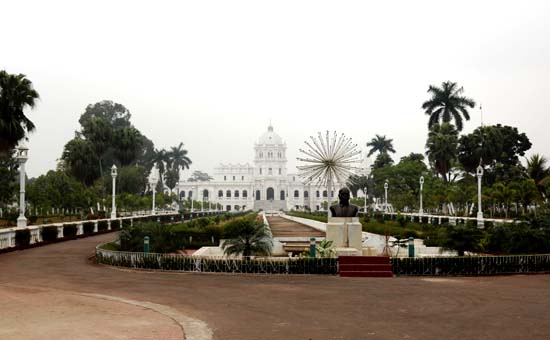 Ujjayanta Palace, Agartala.
Ujjayanta Palace, Agartala.
6. Did Indian Sects fight like those of
Abrahamic religions did?
As per Volume 4 of the Cultural
Heritage of India, “The sentiment about different gods being ultimately forms of the one Being, so beautifully expressed in the famous couplet of the Dirghatamas hymn long before the evolution of the respective cults, never lost its force in subsequent times. Approved Smriti works & the Manu and Yajnavalkya Smritis did not advocate the case of any cult.” Pg. 331
For those propagating North South divide, “The Cholas are said in later-day legends to have brought Saivas from northern India to the Tamil country.” 4 Pg.72
I
am grateful to the filmmaker for raising the Chola issue. More Indians may now
re-discover their non-colonised history.
It
seems the statements were made due to compulsions of local politics. I have
presented information before you. Please decide yourself.
References
1. ‘The Chola Temples’ by the Archaeological Survey of India published in 2004.
2. Seven
Systems of Indian Philosophy Pandit Rajmani Tugnait.
3. The
History and Culture of Indian People published by the Bharatiya Vidya Bhavan.
4. Volume 4 of the Cultural
Heritage of India published by the Ramakrishna Mission Institute of Culture.
Also read
1. Sanskrit Tamil Harmony
2. Tamil Nadu Temple tour program
3. Inscriptions during the Chola era
Article must not be republished without written
permission of www.esamskriti.com.
Unless stated all pictures are clicked by author.